200 Years of Frankenstein
The iconic scientist and his monster have captured us for over two centuries.

2018 marked the 200th anniversary of Mary Wollstonecraft Shelley’s Frankenstein, a story that has inspired hundreds to interpret the tale across a variety of mediums. Some speculate that there has been at least one adaptation every year since it was first published. Whether through literature, novels, comics, illustration, film or stage, we are definitely obsessed with not just sharing but recreating this story for a multitude of audiences.

Frankenstein by Mary Shelley
(published January 1818)
Mary Shelley was just a teenager when she began the story of Frankenstein. It was during the summer of 1816 while she was taking a summer trip in Switzerland with Lord Byron and Percy Shelley, whom she later married. As the summer was plagued with terrible, rainy weather, Lord Byron challenged everyone to an indoor activity; to create a ghost story. At just 18 years old, and after a long evening discussion on the principles of life and death, Mary couldn’t sleep and had a “waking dream” of the tale she would create. Two years later, at age 20 and with the Percy’s collaboration, the short story had extended into a novel and was published.
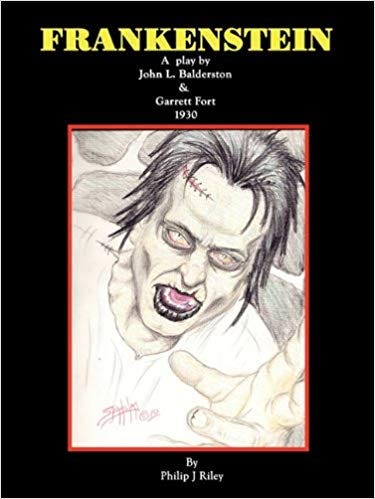
Frankenstein, a play by John L Balderston
(1931)
We could dedicate an entire article just to stage and screen adaptations of Frankenstein, but let’s focus on Frankenstein’s big screen debut. When film was booming in the 1930s, the iconic era of horror sprung to life. Bela Lugosi dominated the screen as Dracula, but while his landmark movie was being filmed, producers were already working on an adaptation of Frankenstein. Enter John Balderston, whose play Dracula was the foundation for the film, and who had initially adapted Peggy Webling’s 1927 play Frankenstein for the American stage. While his Frankenstein never made it to Broadway, it was the basis of the film starring Boris Karloff as “The Creature”. Balderston also went on to help write to script for “The Bride of Frankenstein”.
Fun Facts
- Lugosi initially hoped to play Dr. Frankenstein, but the director intended for him to be the monster. Lugosi ultimately left due to poor screen tests, a decision many think he lived to regret.
- Frankenstein’s faithful assistant, Igor, was first introduced in the film, but never appears in Mary Shelley’s original text.

The Illustrated Frankenstein by Jennifer Anderson
(published August 2010)
This unlikely adaptation was created for young audiences and features beautiful illustrations by Barbara Harris Anderson. This mother/daughter duo who created this work chose to return to a more direct interpretation of Frankenstein’s monster, which disposes of green skin, large foreheads, and neck bolts and focuses on the themes of empathy and human consciousness. Over 25 original paintings accompany this condensed text as it hearkens back to the original Shelley text while still be accessible for young readers.
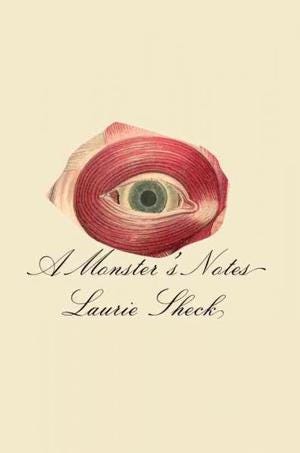
A Monster’s Notes by Laurie Sheck
(published January 2012)
So much of Mary Shelley’s life seeps into the unreal universe of Frankenstein, especially when it comes to loss. The trail of death and illness that follows Victor Frankenstein similarly shadowed Shelley’s real life. And so, in this adaptation, author Laurie Sheck imagines what it would be like if Mary hadn’t created the monster as a story character, but she met him in real life at her mother’s grave. Here the monster’s story is a biography, not her imagination. A Monster’s Notes also sees the creature through his existence into the 21st century and his perception of space exploration, AI, and more. Ultimately, the reader gets to explore the possibility of the monster’s life if he survives the arctic, which is where he is left at the end of Shelley’s novel.
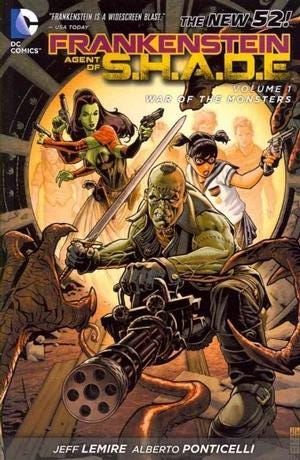
Frankenstein, Agent of S.H.A.D.E., Vol. 1 by Jeff Lemire and J.G. Jones
(published June 2012)
Frankenstein’s monster takes his master’s name, as is often the case in adaptations, in this collection of comics in DC’s New 52. Frankenstein (the monster, not the scientist) is likened by fans to the Hulk and Hellboy, characters that are large, possibly evil, but largely misunderstood. Frankenstein, along with his field team, The Creature Commandos, fight villains even more dangerous and strange than they are as part of The Super Human Advanced Defense Executive (S.H.A.D.E). You’ll find other familiar creatures, such as the Wolf-man, vampires and fish creatures, that all seem to originate from early horror films. Is it true to Mary Shelley’s novel? Not really. Will you love it anyway? For sure.
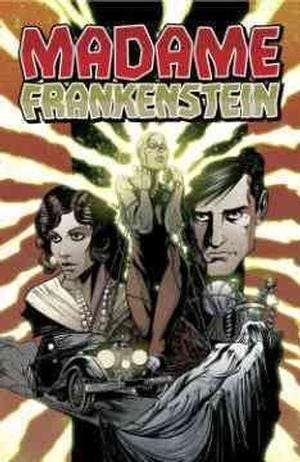
Madame Frankenstein by Jamie S. Rich, Megan Levens, and Joelle Jones
(published May 2014)
Weird Science meets the Bride of Frankenstein in Madame Frankenstein. It’s the good ole Jazz Age where the skirts are short, the booze flows freely, and Vincent Krall is trying to reanimate the love of his life. You know, the usual. Courtney died in a car crash and when brought back to life, can’t remember anything. Vincent begins to teach her how to be a lady (groan) as Courtney begins to remember her old life, and the reader soon realizes any sympathy place with Vincent was a mistake. A surprisingly effective blend of traditional horror and a modern take on the role of women in society, this graphic novel takes a look at the long-term consequences of reanimation.
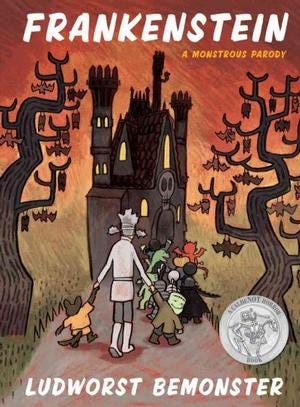
Frankenstein: A Monstrous Parody by Rick Walton
(published August 2016)
Perhaps the most delightful adaptations of Shelley’s tale are in the form of parody. Such is the case in Rick Walton’s picture book. This family-friendly interpretation takes after the classic children’s book Madeline by Ludwig Bemelmans. It’s even written in rhyme! Instead of “twelve little girls in two straight lines” you’ll see “twelve little ghouls in two crooked lines”. The story will delight children with its silliness and charm adults for it’s spot-on transformation of a childhood classic.

Frankenstein in Baghdad by Ahmed Saadawi
(published January 2018)
It’s always a treat to read an adaptation that is rooted in modern day circumstances. Frankenstein in Baghdad takes the story out of Europe and directly into contemporary Iraq. Oddball Hadi searches the rubble-strewn streets of Baghdad for body parts to create one whole corpse. His goal is NOT reanimation, but to seek a proper burial for the people destroyed and forgotten by ongoing violence. Hadi’s creation goes missing, and shortly after reports abound of a string of murders by a mysterious creature that cannot be killed by gunshots. Ahmed’s brilliant work has been translated from it’s original Arabic, also making a great expansion to contemporary works in translations.

The Dark Descent of Elizabeth Frankenstein by Kiersten White
(published September 2018)
Much of Mary Shelley’s novel is composed of letters that Victor Frankenstein wrote to Elizabeth Lavenza. Victor Frankenstein fell in love with Elizabeth the moment he saw her as a young boy. Raised together as companions, he always knew they would one day be married, and the feelings were mutual. In The Dark Descent of Elizabeth Frankenstein, the point of view moves away from Victor and his monster and illuminates Elizabeth’s perspective. Through her eyes, we see the dark side of Victor and the determination of a woman who is fighting an incoming darkness that no one else can see.
Other adaptations we love.
The Rocky Horror Picture Show
Mel Brooks’ Young Frankenstein
Penny Dreadful
Frankenstein, the Off-Broadway musical
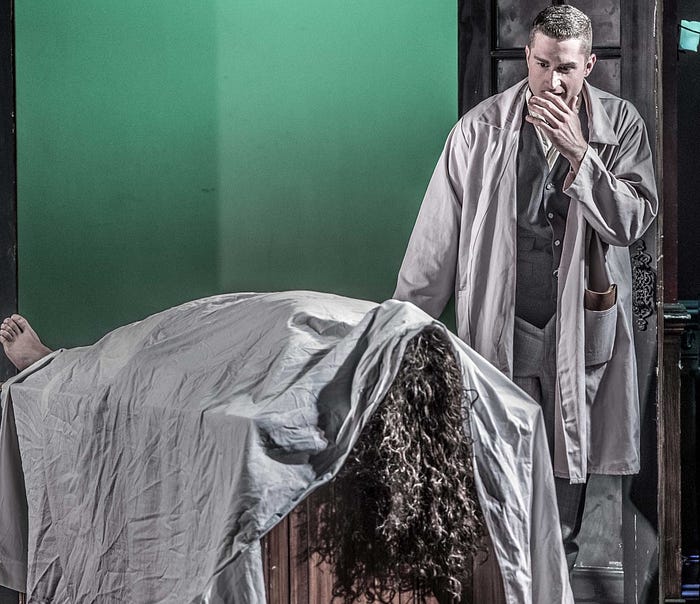
Frankenweenie
and of course, The Munsters
If you like what you read, give us a 👏 so other readers can enjoy it too!

Follow Strand on Instagram 📷, Twitter 🐥, Facebook 👤, Tumblr, and Pinterest. Sign up for our 📩 Strand Insider Newsletter 💌!
